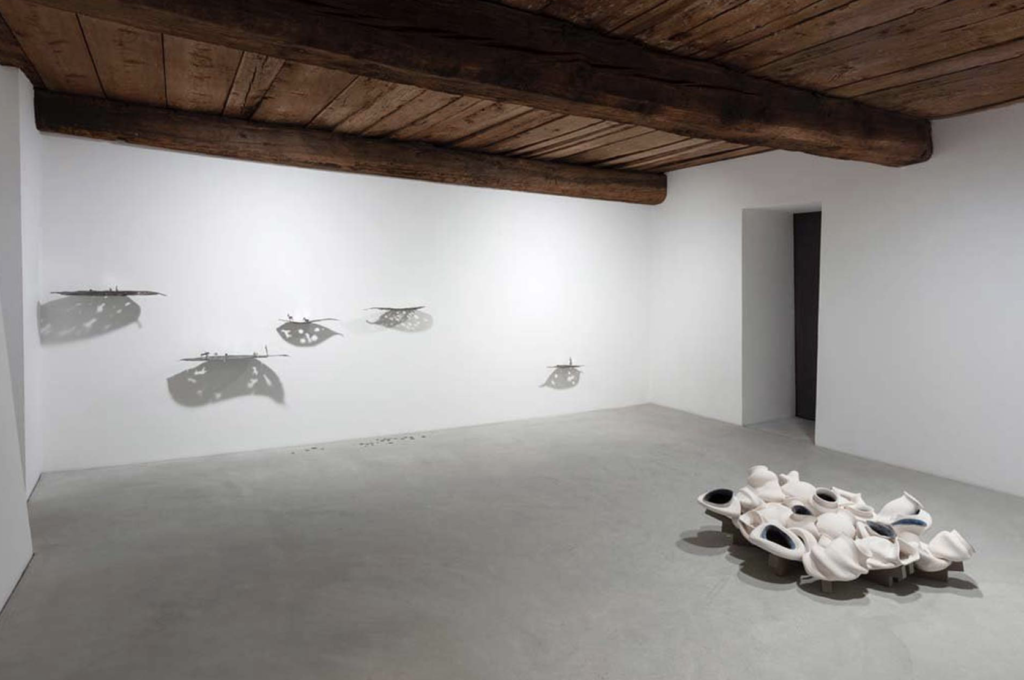Galleria Monica de Cardenas, Zuoz, 25. Juli – 29. August 2020.
Text by the Gallery: „The exhibition by Claudia Losi speaks of departures and destinations, of passages on the earth: an imaginary and imagined pilgrimage between the history of humankind and the personal concerns of the artist. To restore a connection with the earth, in this very fragile ecosystem, suggests a different idea of identity that stems from feeling a bond with other life forms. Losi’s works are musings on origins and cyclical transformation in nature, „solidifications“ of moments of life between permanence and impermanence, which reveal themselves to the eyes of the visitor in silent transit through small stations, where it is possible to linger and ponder. The materials used by the artist for her works are bearers of an ancient, patient handiwork: iron, bronze, wood, silk, ceramics.
The forms come together and overlap to bear witness to the constant process of evolution that rules in nature: the Sfere (Spheres) in wood release boughs and limbs in an eternal dance, as happens with the forms of animals in the hollows of the vases of Gesti Dentro (Inner Gestures). An invitation to consider a state of „naturalness“ in which living beings have no barriers of species. Her works are choral and personal geographies in which an “ecological action” leads to the rebirth of what has been lived, or also simply imagined: the Lingue foglia (Leaf Tongues) bring out collective stories of humankind, presenting themselves as little theaters with scenes of travel and hunting, in which the protagonist is the mutual relationship between human and animal. The eye (represented) and the gaze (evoked and suggested by spirals and circles) are recurring subjects in the artist’s practice. Poli Antarctici (Antarctic Poles), a large embroidery produced through patient group effort, links back to the idea of a large aquatic iris. In Gesti Dentro the collapsing of vases onto one another suggests the figure of a whirlpool, while the background incorporates deep blue glazes that remind us of the waves of the sea. Here again, the eye is engraved on the sandstone sphere placed in a fishing net (Pietraocchio) and the embroidery with horsehair of the planet Earth (Sferamondo), taken from an illustration by Athanasius Kircher, amplifies the connection between macrocosm and microcosm: everything is recalled and rejoins in a sort of Panic energy in which we feel we are engaged, to look inward and to look more closely. In the end, there is the need for protection that has accompanied human history from its origins: Asking Shelter, the impossible house-refuges, but also the crowns of thorns (Le sue mani insegnarono pazienza / The hands taught patience) and the series of small Amuleti (Amulets), shaped over the last three months of isolation day after day, are artifacts that act as good omens, keepers of positive energy. There is beauty in survival and fertility in hope. You must change your disposition, not your sky (animum debes mutare, non caelum), Seneca wrote to Lucilius.– Marina DacciClaudia Losi was born in 1971 in Piacenza, where she lives and works. Recent solo exhibitions include MAMbo, Bologna, 2020; Ikon Gallery, Birmingham, 2019 and Collezione Maramotti, Reggio Emilia, 2016. She has also shown work at La Maréchalerie, Versailles; the MAXXI Museum, Rome; MAGASIN, Grenoble; Royal Academy, London. In 2008 she had a solo show at Museo Marino Marini, Florence, and at the Stenersen Museum, Oslo. In 2007 she took part in the Sharjah Biennial 8, United Arab Emirates, and in 2016 at the Hangzhou Triennial of Fiber Art, China. From 2004 to 2011 she developed the Balena Project: the mythical account of a fin whale made in actual size in fabric, which traveled the world involving people and imaginaries at each passage. The project will be narrated in a special publication titled The Whale Theory, programmed for the start of 2021.“


